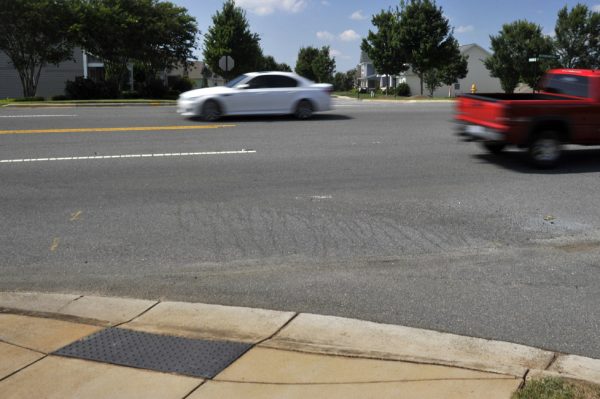Charlotte ranked 10th most dangerous metro for pedestrians

It’s not easy getting around the Charlotte region on foot. It can be deadly, too. The Charlotte-Concord-Gastonia area ranks 10th most dangerous metro for pedestrians, according to a study, Dangerous by Design, released this week by the National Complete Streets Coalition and Smart Growth America. Last month, Smart Growth America ranked the Charlotte metro as the fifth most sprawling ** in the nation.
Researchers calculated a Pedestrian Danger Index (PDI) for each of the 51 largest metro areas in the United States. The Charlotte metro’s PDI (pedestrian deaths per 100,000/percentage who walk to work) was 111.74, more than twice as high as the national average of 52.1. The annual rate of pedestrian fatalities in Charlotte was 1.65 per 100,000 people. About 1.5 percent of Charlotte area commuters walk to work.
According to the report, 254 pedestrians died on Charlotte area streets in the decade from 2003-2012. Pedestrians accounted for 14.5 percent of traffic fatalities in Charlotte during the same period, on par with the national average.
The most dangerous metros were in the South or West and experienced most of their growth post-World War II, when cities were designed for the car. Retrofitting roads built during this era can be a challenge for local governments, and that in part explains Charlotte’s dangerous rank. The study also groups the city of Charlotte with six of its surounding counties. Over the past decade, the city has worked with state agencies to make pedestrian improvements on major thoroughfares where pedestrian fatalities have occurred. The Charlotte Department of Transportation’s Complete Streets program, implemented in 2007, won a national award from Smart Growth America in 2009. The American Planning Association cited Charlotte’s Complete Streets program as a model for other cities in its 2010 manual Complete Streets: Best Policy and Implementation Practices.
“Rather than just saying pedestrians and bicyclists were to be accomodated, (Complete Streets) made it so they were an integral part of the plan” for each street, said CDOT Traffic Safety Manager Debbie Smith.
The number of pedestrian fatalities in the city of Charlotte rose from from nine in 2008 to 21 in 2012, but fell to nine in 2013. Charlotte’s population increased by almost 100,000 people during the same period. Smith says its difficult to say how much street design impacts fatalities in Charlotte.
“When you look at fatalities, there’s just no one clear commonality,” she said. “You have lots of contributing circumstances like distracted driving.”
The top four most dangerous metros were in Florida, led by Orlando-Kissimmee, where the PDI was 244.28. Tampa, Jacksonville, Miami, Memphis, Tenn., Birmingham, Ala., Houston, Atlanta and Phoenix were all ranked more dangerous than Charlotte. The Raleigh-Cary metro ranked 16th most dangerous with a PDI of 100.35. North Carolina overall ranked the 9th most dangerous state with a PDI of 99.8. Nine of the 11 most dangerous states are in the South.
The safest metros for pedestrians, according to the report, were older cities with compact street grid patterns and a high percentage of people who walk to work. Metros with the lowest PDIs include Boston (18.65), Pittsburgh (25.10), New York (28.43), Seattle (26.81), San Francisco (31.44), Minneapolis (32.15), Portland (32.19), Chicago (32.94), Rochester, N.Y. (33.97), and Cleveland (34.39).
Two differences between the safest and most dangerous metros are street design and speed. Pedestrians hit by cars going 45 mph are 11 times more likely to be killed than those hit at 20 mph. In Charlotte, 67 percent of pedestrian fatalities occurred on streets with speed limits of 40 mph or higher. The report recommends reducing traffic speeds through design changes like wider sidewalks, street parking and lower speed limits. The report also recommends strengthening the federal Transportation Alternatives Program and adopting the federal Safe Streets Act, which would require all federally funded road projects to “consider the safety of all travelers, including those who are walking, taking public transportation, bicycling and driving, regardless of age or ability.”
Also in the report:
- About half of the pedestrians killed nationwide during the 2003-2012 period died on arterial roads – those designed to move high volumes of automobile traffic over long distances at high speeds with little delay. Smith said 71 percent of pedestrian fatalities occured on arterial roads In Charlotte.
- Blacks, Hispanics, Native Americans and senior citizens had higher rates of pedestrian fatalities than younger people, whites or Asians.
- 27 percent of fatalities nationwide occurred in rural areas. These were not included in the study results.
** Correction: An earlier version of this article mistakenly said the Charlotte region was sixth most sprawling, instead of fifth.